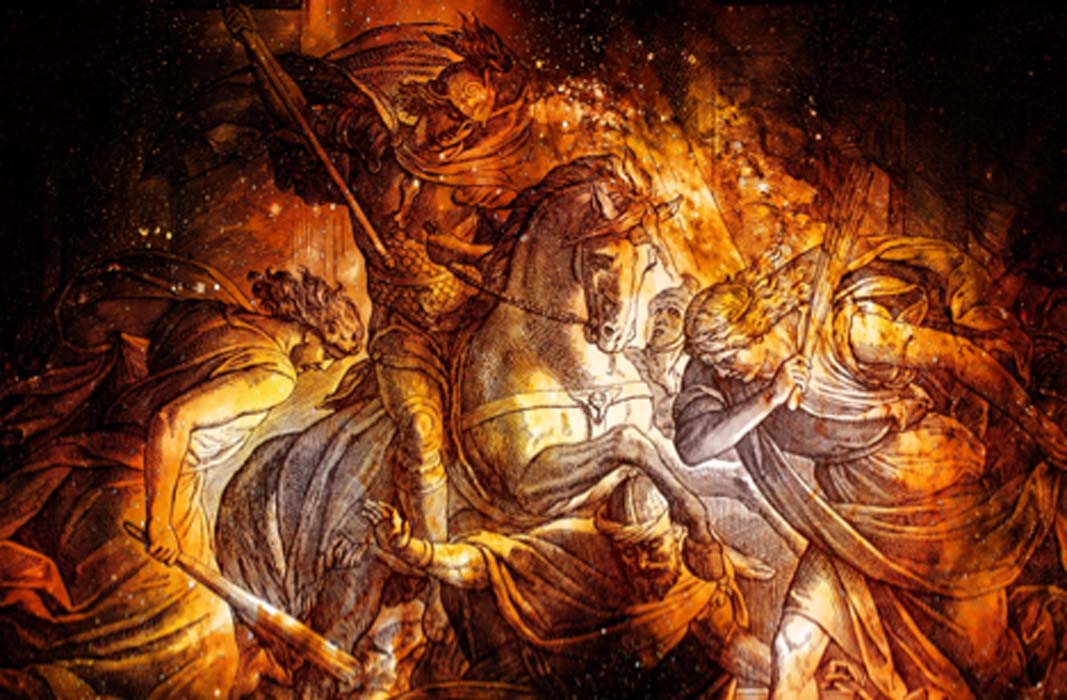2,800-Year-Old Altar Inscription Talks Of Biblical War
Two inscriptions found on an ancient carved altar are revealing new information about a rebellion against the Kingdom of Israel that is described in the Bible.
The 2,800 year-old cylindrical stone altar was discovered in a sanctuary within the ancient city of Ataroth in Jordan and it bears two inscriptions referring to a biblical war. Located within a Moabite sanctuary in the ancient city of Ataroth in Jordan during excavations in 2010, the language and script is in ancient Moabite while the numerals are executed in an Egyptian writing system known as Hieratic.

Inscribed altar from the Khirbat Ataruz Moabite sanctuary. (Image: © Adam Bean)
Analysis of Stone Altar Inscriptions
Both the sanctuary and the carved altar were recently analyzed and described in the journal Levant which says the altar dates to after the time Mesha, king of Moab “rebelled against the Kingdom of Israel conquering Ataroth” dividing the territory into a northern kingdom (Israel) and a new southern kingdom (Judah).
A Live Science report discusses an entry in the Hebrew Bible mentioning the rebellion saying that before Mesha rebelled, Moab gave Israel a yearly tribute of “thousands of lambs and a vast amount of ram wool”. The so-called Mesha stele was discussed in an earlier Live Science article which has details of its 1868 discovery in Dhiban, Jordan, and the inscription claiming Mesha “conquered Ataroth and killed many of the city's inhabitants”.

The Mesha Stele - the brown fragments are pieces of the original stele, whereas the smoother black material is Ganneau's reconstruction from the 1870s. (Mbzt / CC BY-SA 3.0)
Ancient Scratches Of Skilled Scribes
Lead author of the research paper, Adam Bean, a doctoral student in the Department of Near Eastern Studies at Johns Hopkins University in Baltimore wrote, “incense, aromatic woods and oils would have been burned on the altar”. The researchers also wrote in the journal article that one of the two altar inscriptions describes “bronze plundered after the capture of Ataroth” and that the second inscription on the altar is fragmentary and therefore much harder to interpret. However, it appears to mention “the desolate city” (capture of Ataroth) and that “4,000 foreign men were scattered and abandoned in great number”.
- Riders On The Storm: Ancient Clay Horse Heads Emerge After Heavy Rain In Israel
- Only 11 Tribes of Israel? Controversial Findings Reveal Danites Might Not Be Sons of Israel But Sons Of Greece
- Remote Israeli Cave Holds A Potted Mystery

The altar inscription describes the capture of Ataroth and the fleeing of the residents. (SteinsplitterBot / Public Domain)
Speaking to Live Science, the study’s co-author, Christopher Rollston, a professor of northwest Semitic languages and literatures at George Washington University in Washington, D.C., states the main finding in this new research is that the inscribed altar confirms that 2,800 years ago the Moabites did indeed take over Ataroth.
What’s more, archaeologist now know that Moabites employed ‘skilled scribes’ who used their own script and the inscriptions on the altar “are the earliest evidence we have so far for a distinctive Moabite script,” Rollston told Live Science, noting that the “inscription discovered in 1868 used the Hebrew script to write the Moabite language”.
Exploring Ataroth
Today, Ataroth is called Khirbat Ataruz and all excavations at the site are led by Chang-Ho Ji, the Dean of Education at La Sierra University in Riverside, California. The project website says the study aims to “discover, preserve, and protect historical and cultural resources of Khirbat Ataruz” and that the ancient site encloses “one of the most magnificent Iron Age temples in the region of Levant, Middle East, one dated to about 3,000 years old”.
A 2013 Sydney Morning Herald article says Jordanian and US archaeologists discovered this 3000-year-old three-story Iron Age temple, which has a multi-chambered sanctuary and open courtyard, in Khirbat Ataruz, and “it is the largest and most complete in the region,” the statement said. This excavation unearthed more than “300 Moabite artifacts, including a figurine of four-legged animal god Hadad”.

A statue of the god Hadad was also found at the site. (Pdulieu / CC BY-SA 4.0)
Ataruz was resettled in the Middle Islamic period (ca. 1000-1400 AD) and although there are a number of walls associated with this period, the building stone used in the construction of the early-mid Iron Age temple complex was dismantled during the Middle Islamic period. Scientists find stone robbing was particularly extensive in the area to the north of the acropolis but regardless, Ataruz was a populous and thriving village during the Middle Islamic period.
Top image: Representation of the biblical war mentioned on the altar inscription. Source: fluenta / Adobe Stock.
By Ashley Cowie



















